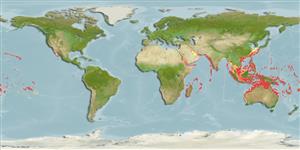Environment: milieu / climate zone / depth range / distribution range
Ecología
marino asociado a arrecife; rango de profundidad 1 - 113 m (Ref. 90102). Tropical; 33°N - 34°S, 32°E - 109°W
Indo-Pacific: Red Sea, East Africa, Comoro Islands and Mascarenes, east to the Hawaiian Islands, Line Islands and Pitcairn Group, north to southern Japan, south to Joseph Bonaparte Gulf (northern in front of Western Australia), New South Wales (Australia), Lord Howe, Norfolk, Kermadec Islands, New Caledonia, Tonga and Gambier Islands (Ref. 86817). Reported from Easter Island (Ref. 89467). Records from Eastern Pacific in Mexico and Panama need further confirmation.
Length at first maturity / Tamaño / Peso / Age
Maturity: Lm 24.0, range 21 - ? cm
Max length : 39.8 cm FL macho / no sexado; (Ref. 125599); common length : 25.0 cm TL macho / no sexado; (Ref. 30573); peso máximo publicado: 1.1 kg (Ref. 125599)
Espinas dorsales (total) : 8; Radios blandos dorsales (total) : 9; Espinas anales: 1; Radios blandos anales: 7. Back red-orange, sides and belly whitish; yellow longitudinal band present; no dark blotch on under middle of 1st dorsal fin (Ref. 5405). All fins yellow (Ref. 48636). Head length 2.9-3.4 in SL, length of snout 2.2.-2.6 and barbel 1.2-1.5 in HL. Body depth 3.4-4.5 in SL. (Ref. 90102)
This occasionally schooling species inhabits sandy bottoms of reef flats, lagoons, coastal and seaward reefs (Ref. 9710, 90102). Benthopelagic (Ref. 58302). In large inactive aggregations by day, dispersing to sand flats to feed at night (Ref. 9710). Sometimes mixes with blue-striped snapper Lutjanus kasmira and shows blue stripes (Ref. 48636). Feeds on small worms and crustaceans. Also caught using ringnets (Ref. 5213). Minimum depth reported taken from Ref. 30874.
Life cycle and mating behavior
Madurez | Reproducción | Puesta | Huevos | Fecundidad | Larva
Myers, R.F., 1991. Micronesian reef fishes. Second Ed. Coral Graphics, Barrigada, Guam. 298 p. (Ref. 1602)
IUCN Red List Status (Ref. 130435: Version 2024-1)
Threat to humans
Harmless
Human uses
Pesquerías: comercial; pesca deportiva: si
Herramientas
Special reports
Download XML
Fuentes de Internet
Estimates based on models
Preferred temperature (Ref.
123201): 24.3 - 28.9, mean 27.7 °C (based on 1376 cells).
Phylogenetic diversity index (Ref.
82804): PD
50 = 0.5078 [Uniqueness, from 0.5 = low to 2.0 = high].
Bayesian length-weight: a=0.01023 (0.00888 - 0.01179), b=3.09 (3.05 - 3.13), in cm total length, based on LWR estimates for this species (Ref.
93245).
Nivel trófico (Ref.
69278): 3.9 ±0.44 se; based on food items.
Resiliencia (Ref.
120179): Medio, población duplicada en un tiempo mínimo de 1.4-4.4 años (K=0.20-0.97).
Fishing Vulnerability (Ref.
59153): Low vulnerability (24 of 100).
Nutrients (Ref.
124155): Calcium = 54.8 [29.5, 90.0] mg/100g; Iron = 0.594 [0.271, 0.987] mg/100g; Protein = 18.9 [17.1, 20.5] %; Omega3 = 0.173 [0.115, 0.318] g/100g; Selenium = 42 [25, 73] μg/100g; VitaminA = 62.3 [21.7, 216.6] μg/100g; Zinc = 1.04 [0.66, 1.46] mg/100g (wet weight);
